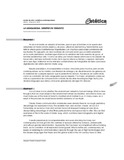Mostrar el registro sencillo del ítem
La vanguardia: siempre en tránsito
| dc.rights.license | http://creativecommons.org/licenses/by-nc-sa/3.0/ve/ | |
| dc.contributor.author | Bello Guerrieri, Reynaldo | |
| dc.date.accessioned | 2010-05-03T22:00:05Z | |
| dc.date.available | 2010-05-03T22:00:05Z | |
| dc.date.issued | 2010-05-03T22:00:05Z | |
| dc.identifier.uri | http://www.saber.ula.ve/handle/123456789/30948 | |
| dc.description.abstract | No sé si el medio se adapta al hombre, pero sí que al hombre no le queda sino adaptarse al medio donde respira y, de paso, utilizar los elementos y herramientas que éste le ofrece para manifestar sus inquietudes y en muchos casos dejar constancia de sus rituales. Por supuesto, en esos avatares de comunicación que ya están presentes en la cruda prehistoria, avatares que intuimos no estaban del todo exentos de goce, el hombre sensible hizo arte. Y como se sabe, por fortuna desde entonces no ha dejado de hacer arte y siempre echando mano de lo que le ofrece su tiempo y espacio. Ejemplos de lo que digo, hallamos en los trabajos combinatorios de holografías de láser y procesos digitalizados del artista alemán Dieter Jung. Resulta paradójico, incomprensible e incluso chocante para muchos, pero el arte contemporáneo se ha metido con libertad de entrega y sin discriminación de géneros en la vastedad de cualquier espacio que le presente la ciencia. Al parecer, sin vuelta atrás, como es condición de toda vanguardia que se respete. Y lo mejor, ampliando cada vez más su capacidad de comunicación a través de las altas tecnologías (High Tech) y los diversos lenguajes que éstas y el mundo globalizado del siglo XXI ofrecen. | es_VE |
| dc.language.iso | es | es_VE |
| dc.rights | info:eu-repo/semantics/openAccess | |
| dc.title | La vanguardia: siempre en tránsito | es_VE |
| dc.type | info:eu-repo/semantics/article | |
| dc.description.abstract1 | It is not clear to me whether the environment adapts to human beings. What is clear though is that we must adapt to the environment where we breathe, and what is more, we must make use of the tools at hand to manifest what matters to us. In many cases, as a result of this process we would leave behind evidence of our rituals. Clearly, these communication vicissitudes were already there in our rough prehistory, discerningly not exempted of joy. The sensible men and women made art out of it Fortunately, as we know, men and women have not stopped making art ever since, always taking advantage of what their particular time and space has to offer. We can find examples of this in the works of Dieter Jung, which combine laser holography and digital processes. It results paradoxical, incomprehensible and even shocking for many, but contemporary art has got into the vastness of spaces offered by science, unreservedly and without gender discrimination. Apparently, this has been accomplished without looking back, as it is condition of all respected avant-guard. What is better yet, contemporary art keeps on widening its communicative capacity through the use of high technologies and the diverse languages that these and the global world of the XXI century have to offer. | es_VE |
| dc.description.colacion | 151-158 | es_VE |
| dc.description.frecuencia | semestral | es_VE |
| dc.identifier.depositolegal | 199702ME179 | es_VE |
| dc.subject.centroinvestigacion | Centro de Investigaciones Estéticas (CIE) | es_VE |
| dc.subject.facultad | Facultad de Humanidades y Educación | es_VE |
| dc.subject.thematiccategory | Artes y Humanidades | es_VE |
| dc.subject.tipo | Revistas | es_VE |
| dc.type.media | Texto | es_VE |
Ficheros en el ítem
Este ítem aparece en la(s) siguiente(s) colección(ones)
-
Estética - Nº 014
enero - junio 2009



